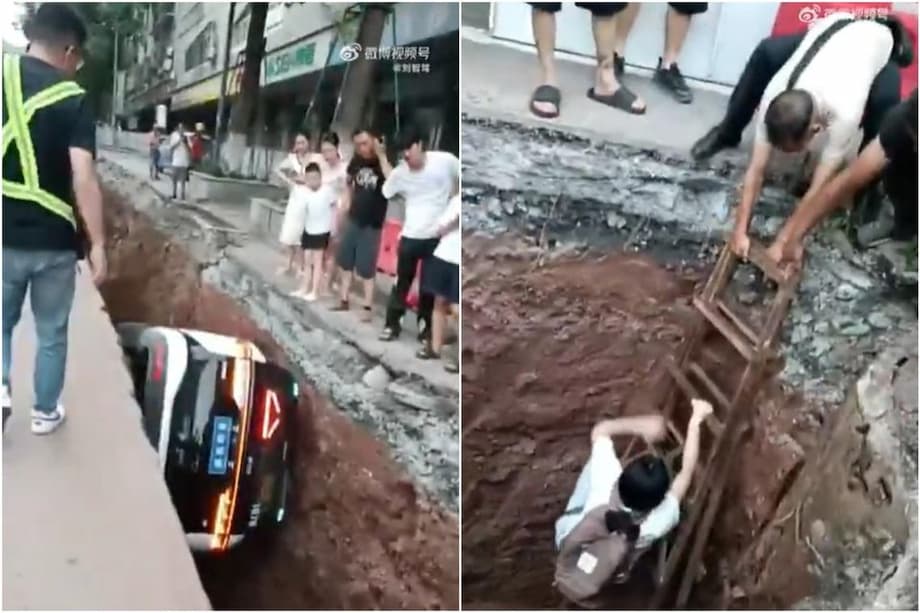Baidu Robotaxi Accident in Chongqing: A Wake-Up Call for Autonomous Vehicle Safety
On August 6, 2025, a Baidu Apollo Go robotaxi carrying a passenger fell into a deep construction pit in Chongqing, southwestern China. The incident, captured on video and widely shared across Chinese social media, has reignited a global debate about the safety and readiness of autonomous vehicles (AVs) for public roads. The female passenger, though shaken, was uninjured and rescued by local residents using a ladder. The white Baidu-branded vehicle was seen lodged at the bottom of a trench, surrounded by construction debris, raising urgent questions about the technology’s ability to handle real-world hazards.
- Baidu Robotaxi Accident in Chongqing: A Wake-Up Call for Autonomous Vehicle Safety
- How Did the Accident Happen?
- Why Are Construction Pits a Challenge for Self-Driving Cars?
- Public Reaction: Social Media and Regulatory Scrutiny
- Baidu’s Robotaxi Ambitions and the Global Race for Autonomy
- Balancing Innovation and Safety: The Road Ahead
- What Does This Mean for Passengers and Cities?
- In Summary
How Did the Accident Happen?
The precise sequence of events leading to the crash remains unclear. Local media and eyewitnesses reported that the construction site was equipped with barriers and warning signs, standard safety measures intended to prevent vehicles and pedestrians from entering hazardous areas. However, it is not yet known how the robotaxi bypassed these precautions. Some video footage suggests that, despite the presence of barriers, the trench may not have been fully roped off, and pedestrians could approach its edge freely. This ambiguity has fueled speculation about whether the vehicle’s sensors failed to detect the pit, or if the site’s safety measures were insufficient.
According to a local shop owner interviewed by multiple outlets, “the construction site had barriers and warning signs, but it is unclear how the vehicle managed to bypass these safety measures.” Baidu has not yet issued an official statement explaining the cause of the accident, and authorities are reportedly investigating the circumstances.
Why Are Construction Pits a Challenge for Self-Driving Cars?
Autonomous vehicles rely on a combination of sensors—such as cameras, radar, and lidar—to perceive their environment. These systems are designed to detect obstacles, read road signs, and interpret traffic signals. However, certain hazards, like open construction pits, present unique challenges. Large holes in the road can be difficult for sensors to detect, especially if they are not clearly marked or if the visual cues are ambiguous.
This is not a new problem. In 2023, internal documents from General Motors’ Cruise self-driving taxi operation reportedly acknowledged that their AVs struggled to detect large holes in the road, including construction pits. Industry experts have long warned that while self-driving cars excel in predictable environments, they remain vulnerable to unexpected hazards and non-standard road layouts.
Industry analyst Li Wei explained, “Autonomous vehicles are trained on vast datasets, but rare or unusual scenarios—like an unmarked pit—can fall outside their programmed detection parameters. This is a critical safety gap that must be addressed before widespread deployment.”
Comparisons to Previous Incidents
The Baidu crash echoes other high-profile failures in the autonomous vehicle industry. In 2018, an Uber self-driving car in Arizona struck and killed a pedestrian after misclassifying her presence until it was too late to avoid impact. More recently, in May 2025, a Pony.ai robotaxi caught fire in Beijing after a system malfunction, though no passengers were on board at the time. In San Francisco last year, a crowd set fire to a Waymo robotaxi that had driven into streets crowded with revelers, sparking debate about the judgment capabilities of robotic cars.
Public Reaction: Social Media and Regulatory Scrutiny
The Chongqing accident has triggered widespread discussion on Chinese social media platforms, with many users expressing concern about the reliability of self-driving technology. Some questioned whether AVs are truly ready for deployment in complex urban environments, while others called for stricter safety standards and oversight.
A user on a self-driving car forum wrote, “If a robotaxi can’t recognize a giant hole in the road, how can we trust it to keep us safe in more complicated situations?”
Regulators have taken notice. Earlier this year, China’s Ministry of Industry and Information Technology convened meetings with over 60 automotive firms to stress compliance with safety standards and to crack down on misleading marketing that suggests full autonomy. In March 2025, Beijing introduced new rules requiring trained safety personnel during all road tests and established clear frameworks for liability in case of accidents. The Baidu incident is expected to accelerate these regulatory efforts, with public trust in robotaxis hanging in the balance.
Baidu’s Robotaxi Ambitions and the Global Race for Autonomy
Baidu operates one of China’s largest autonomous vehicle fleets, with its Apollo Go service active in cities including Beijing, Wuhan, and Chongqing. The company has been aggressively expanding, recently announcing partnerships with U.S. ride-hailing giants Uber and Lyft to bring its robotaxi technology to international markets. Baidu’s ambition is to become a global leader in autonomous mobility, deploying thousands of self-driving taxis across Asia, the Middle East, and Europe in the coming years.
However, the Chongqing crash and the ensuing social media storm may complicate these plans. Public confidence is a crucial factor for the adoption of autonomous vehicles, and repeated safety lapses risk slowing both market growth and regulatory approvals. Investors and industry observers are closely watching how Baidu and its competitors respond to these challenges.
Industry Competition and Recent Setbacks
Baidu is not alone in facing scrutiny. Chinese rival Pony.ai and American companies like Waymo and Cruise have all encountered setbacks, from technical failures to public backlash. In the United States, nearly 4,000 autonomous vehicle incidents had been reported by June 2024, underscoring the complexity of deploying self-driving technology at scale.
Despite these challenges, the industry continues to push forward. Companies are investing heavily in research and development to improve sensor accuracy, decision-making algorithms, and fail-safe mechanisms. The hope is that, over time, AVs will become safer than human drivers, who are responsible for the vast majority of road accidents worldwide.
Balancing Innovation and Safety: The Road Ahead
The Baidu robotaxi accident in Chongqing serves as a stark reminder that innovation must advance hand-in-hand with robust safety systems and responsive oversight. While autonomous vehicles promise to reduce traffic fatalities, increase mobility, and transform urban transportation, they must first prove their ability to handle the unpredictable realities of city streets.
Experts argue that a multi-layered approach is needed. This includes:
- Improved sensor technology capable of detecting a wider range of hazards
- Enhanced mapping and real-time data sharing between vehicles and infrastructure
- Stricter regulatory frameworks and transparent accident reporting
- Ongoing public education and engagement to build trust
As China and other countries race to lead the autonomous vehicle revolution, the lessons from Chongqing will likely shape the next generation of safety standards and operational protocols. The incident has already prompted calls for more rigorous testing, better collaboration between technology firms and city planners, and a renewed focus on passenger safety.
What Does This Mean for Passengers and Cities?
For passengers, the Chongqing accident is a sobering reminder that self-driving cars are still an emerging technology. While the promise of safer, more efficient transportation is real, the technology is not infallible. Passengers should remain vigilant and informed about the capabilities and limitations of AVs, especially during the early stages of deployment.
For cities, integrating autonomous vehicles into existing infrastructure presents both opportunities and challenges. Urban planners must ensure that construction sites, roadworks, and other hazards are clearly marked and communicated to both human drivers and AVs. Collaboration between city authorities, construction companies, and AV operators will be essential to prevent similar incidents in the future.
In Summary
- A Baidu Apollo Go robotaxi carrying a passenger fell into a construction pit in Chongqing, China, on August 6, 2025. The passenger was uninjured and rescued by local residents.
- The incident has sparked widespread debate about the safety and readiness of autonomous vehicles, especially in complex urban environments.
- Industry experts highlight that AVs still struggle with rare or unusual hazards, such as unmarked construction pits, which may fall outside their programmed detection capabilities.
- Chinese regulators are increasing oversight and introducing stricter safety standards in response to recent AV incidents.
- Baidu’s global expansion plans may face challenges as public confidence in robotaxis is tested by high-profile accidents.
- The future of autonomous vehicles depends on improved technology, robust regulation, and ongoing public engagement to ensure safety and trust.












